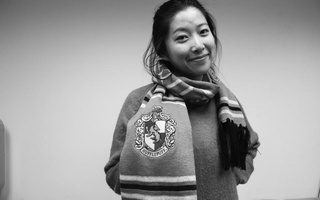Last Spring, I put on the hijab. For one week, I woke up every morning, and despite the fact that the sun had only just remembered to shine and most Harvard students were shedding their clothes, I pinned a scarf to my head and dressed myself so that nothing but my face and hands were bare. I was in a typical costume for a Muslim woman in the West, if there is in fact such a thing, except for one detail. Instead of the regular bonnet that is worn to keep hair neat and hidden under the veil, I tied a do-rag around my head because CVS keeps do-rags in stock and not bonnets for Muslims.
In some ways I was trying to put myself in the shoes of a Muslim woman in the West who chose to wear the hijab. Of course, there were many limitations to this project, and wearing the headscarf by my own choice for the short span of a week only presented a small set of data relative to the general experience of a person in that position. But in any case, this was not a complete description of what I was trying to accomplish. I had been intrigued by something so simple as a piece of cloth.
The hijab has been used as a symbol of nationalism in countries other than this one and as a symbol of oppression in countries including this one. Encompassed in this scarf, tied this way, are powerful ideas of faith, piety and identity: ideas I wanted to engage through simply playing with a piece of cloth. As a child puts a toy in her mouth in order to know it better, I put the scarf on my head to come as viscerally close as I could to understanding this symbol.
Under those terms, this was a successful experiment. When it came to external experiences with the hijab, as in dealing with other people’s reactions to it or the functionality of wearing it, I had a wide array of reactions and a few surprising discoveries. The general public, the Harvard student body, and acquaintances seemed to treat me with a greater degree of respect. I felt as if I was wearing my Sunday best all the time and enjoyed the experience of better service in stores and more doors held open for me. Amongst my close friends, the reactions were split. Some practically forgot that I was wearing the headscarf at all. Kind as they are to excuse me when I live in my sweatpants, they extended the same courtesy of nonchalance to my new headdress. Others were very supportive, and told me that they thought it looked attractive. For a few people, it proved to be a very uncomfortable and disconcerting experience. My suspicion is that although they are ordinarily quite used to interacting with people who are obviously different from them, they approach those people at arm’s length and do not see them as people that they can expect to relate to or understand. When I wore the headscarf as somebody that they did relate closely to and expected to understand, traversing the distance between foreign stranger and well-known friend was an unexpectedly side chasm to bridge.
But it was also very interesting to notice the internal changes that occurred within me as a result of wearing the hijab. More than one person pointed out to me that my mannerisms had become more subdued and more noticeably demure and feminine. For instance, I spoke in a softer tone, always sat with my legs crossed and kept my hands clasped in front of me when I spoke. Particularly on the first day of wearing the hijab, I felt as if I was wearing a protective blanket. On one hand it gave me a sense of security, and on the other hand the shielding effect of the hijab was only an illusion because the act of wearing it made such a strong statement that I was in fact exposing a more vulnerable part of myself. My vulnerability was also more profound because I had little control over the strong statement that I was broadcasting, since it would have been interpreted differently by each observer.
Wearing the hijab taught me a lot about the ways through which we construct and express our identity. I also gained a deeper understanding of how we perceive each other and how minute changes can be experienced as earth-shaking in our subjective contexts. I wondered at the outset if this weeklong experiment would change my opinions on the veil or give me some insight into Islam or American culture, but instead I learned far more about myself and about the people who share my life with me. In the movie Dead Poets Society, the teacher John Keating jumps onto the teacher’s desk and asks his students “Why do I stand up here? Anybody?” Some are horrified at his behavior, some chuckle and some call him crazy. “No!” he shouts, “I stand upon my desk to remind myself that we must constantly look at things in a different way.” In a similar way, I realize that I had covered myself in order to step outside my own experience, only to understand it better.
Shaomin C. Chew ’13 is a comparative study of religion concentrator in Lowell House.
Read more in Opinion
Reflection on International AidRecommended Articles
-
Naked KneesAs the temperature plummets, students face the annual question of whether or not the time has come to pack away
-
Costumes in the ClosetLight blue shorts-jumpsuit? Check. Pleather lined clear visor? Check. Bright green plaid skirt? Check. Halloween is a month and a
-
 J-Term Journal: The Sorting Scarf
J-Term Journal: The Sorting Scarf -
 Who I Was
Who I Was -
 In A Uniform Fashion
In A Uniform Fashion -
Lebanese. Muslim. American.It’s exhausting to have to fight to justify my American identity.













